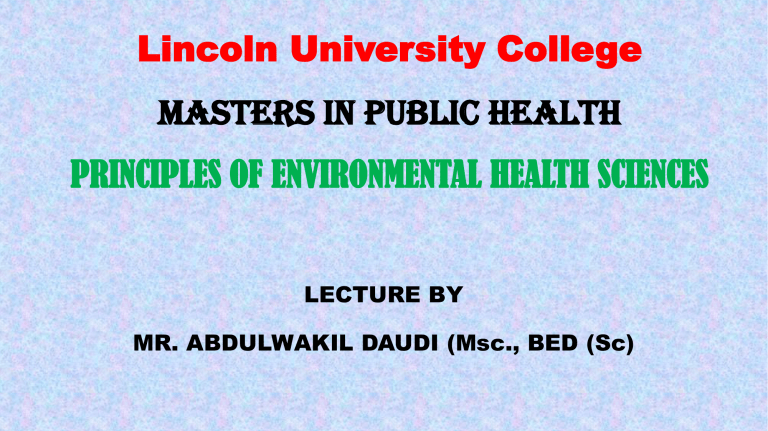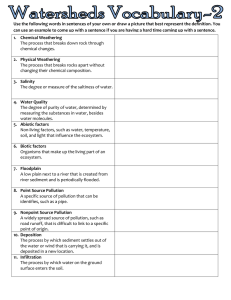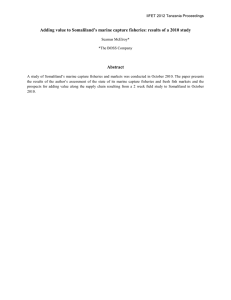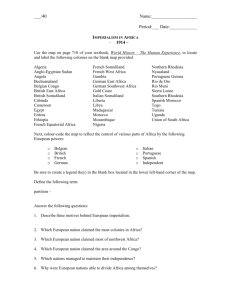
Lincoln University College MASTERS IN PUBLIC HEALTH PRINCIPLES OF ENVIRONMENTAL HEALTH SCIENCES LECTURE BY MR. ABDULWAKIL DAUDI (Msc., BED (Sc) COURSE OBJECTIVES By the end of this course, you will be able to: • Explain the concept and evolution of environmental health • Discuss the causes and the impacts of air pollution, water pollution, noise pollution, radiation pollution and land pollution. • Discuss water resources, water treatment processes and waterborne diseases • Understand food safety and hygiene principles and tools • Understand vector control methods • Explain the different types of sanitation systems and excreta disposal methods • Explain the term ‘hazards’ and discuss different types of hazards • Explain the term “ethics” and the general principles of environmental health ethics trace the origins of environmental justice and explain the term “environmental justice” • Discuss the environmental laws, legislation and governance in Somaliland • Discuss the consequences and impacts of climate change on human health • Explain possible impacts of bioterrorism and preparedness towards bioterrorism attacks MODULES AND UNITS Module Title 1 2 3 4 Environment and Environmental Health Unit 1: Environment Unit 2: Health and Environment Unit 3: Environment and health protection policies End of units Assignments Concepts of Environmental Pollution Unit 1: Water Pollution Unit 2: Noise Pollution Unit 3: Soil Pollution Unit 4: Food Hygiene and Food Pollution Unit 5: Radiation Pollution End of units Assignments Concepts of Disease Causing Agents in the Environment Unit 1: Air borne Diseases Unit 2: Food borne, Water Borne and Vector borne Diseases Unit 3: Life-style Related Diseases End of units Assignments Concepts in Waste Management Unit 1: Dry Refuse or Solid Waste Unit 2: Methods of Final Disposal of Solid Waste Unit 3: Wet Refuse or Liquid Waste Unit 4: Emerging issues in environmental health science End of units Assignments EVALUATION • COURSE WORK-CATS/ASSIGNMENTS: • END OF COURSE EXAMINATIONS: • ATTENDANCE: 40% 50% 10% Module 1 Environment, Ecology, Environmental Health Laws and Regulatory Bodies Mode: Evening Programme UNIT1: ENVIRONMENT OBJECTIVES OF UNIT 1 By the end of this unit, the students should be able to: • Define Environment • Identify the features of our environment • Explain the classes of environment • Discuss the effect of each class of environment on man. • Identify the factors that constitute poor environment • List the consequences of poor environment. Definition of Environment • The word environment is derived from the French word ‘Environer’ meaning 'Neighbourhood‘ or ‘Surroundings.’ • It is the earth you live on, the air you breath in, the animals and trees you live with. • Environment refers to conditions in which man and other organisms including non-living things such as air, water, sunlight, food, housing, soil, atmosphere, thrive and live for each other’s life. • The word “environment” has been given various definitions. It is the whole complete of physical, social, biological, cultural and aesthetic factors which affect individual and communities and ultimately determine their form, character, relationship and survival. • Environment is also defined as the forces, conditions or circumstances that surround and affect lives. Factors in the Environment • Man’s total environment includes all the living and non-living elements in his surroundings which form the two factors of the environment. These factors include Abiotic and Biotic factors. • Abiotic Factors: These are the non-living components in the environment such as climatic factors, e.g., temperature, rainfall, humidity, light, soil and so on. • Biotic Factors: These are the living components such as man, animals, fungi, bacteria, worms and so on. Both the biotic and abiotic components interact together to form a complex relationship. Features of the Environment 1. Lithosphere: The Earth's crust consisting of the rocks and soil is called lithosphere. The soil is made of inorganic and organic matter and water. • The minerals found on the lithosphere are compounds derived from the elements oxygen, silicon, aluminum, calcium, magnesium, potassium, iron, manganese and tin. • Pollutants have penetrated the lithosphere making the food that is grown harmful to humans. Features of the Environment 2. Hydrosphere: Water is essential for life and forms the most important component of the Earth. The hydrosphere is that part of the Earth where water is available. It comprises of about 72 % of the Earth's surface, with 97 % of hydrosphere being sea water and is unfit for human use and, 2 % forms glaciers in the polar caps. Only 1 % is available for human use. Water are responsible for supporting terrestrial and aquatic life on the Earth. Water today is contaminated by numerous pollutants peculiar to modem life. Features of the Environment 3. Atmosphere: • The Earth is surrounded by an envelope made of a mixture of gases called the atmosphere. This extends up to 500 km above the Earth's surface. The main gases in the atmosphere are nitrogen and oxygen, which together forms 99 % by volume. The remaining 1 % are carbon dioxide and inert gases. • The atmosphere protects the Earth from harmful cosmic radiations, maintaining the heat balance of the Earth by absorbing the reflected radiation and its the medium of carriage of water from the oceans to the land in the hydrological cycle. • The atmosphere provides life sustaining oxygen, the soil macronutrient nitrogen and the carbon dioxide needed for photosynthesis. Health problems and diseases are found in slums and settlements, which are congested and lack fresh air. Features of the Environment 4. Biosphere: • This is the part of the Earth and atmosphere in which life is possible and consists of living things exist. It extends from 10,000 m below sea level to 6,000 m above sea level. It covers parts of lithosphere, hydrosphere and atmosphere. Life supporting resources, such as food, water and oxygen present in the biosphere are being withdrawn continuously and increasing quantities of waste products are being dumped into the biosphere. Features of the Environment Classification of Environment and their Effects on Man • Environment can be classified into the following: • Physical Environment • This consists of the naturally existing aspect of the environment. It refers to non-living things such as climatic factors like rainfall, sunlight, humidity and edaphic factors consisting of soil composition, soil farm and soil temperature. • The physical environment has direct effect on man and the effects varied in line with the varied physical environment from place to place. Physical Environment • Natural disasters among which are earthquakes, the waves of the high seas or over flowing of river banks, erosion, desertification and so on. • Physical comfort which comes from the air, temperature, humidity, rainfall and other natural sources. • Distribution of plants and animals in various parts of the earth and presence of vegetation. This gives opportunity for food productions, shelter, clothing, animal rearing and so on. • Provision of different types of ransportation and communication system. For instance, people who live where there is no river or sea travel with motorcycle, motor car and bicycle. • Different places have different seasons such as rainy season, dry season, winter, etc. This affords different opportunities for agricultural activities resulting to varied food productions. • Because of the difference in climatic factors, the distribution of carnivorous animals varies from place to place. Some areas have dangerous animals that prey on man and compete with man for survival. • Parasites such as mosquitoes that cause malaria, black flies that cause filarial are distributed in some tropical areas. Classification of Environment and their Effects on Man • Biological Environment • This refers to the living things in the environment. Under this, we have man, animals, plants and micro-organisms. • • These groups of living things are inter-dependent on each other and absolutely depend on the physical environment for their survival. For instance, the sun is the source of the energy and this energy is trapped by plants during photosynthesis for the manufacturing of its food, animals feed on these green plants (herbivores) while some group of animals feed on other animals (carnivores) or feed on both plants and animals (omnivores). • Death is a natural mechanism which is made to ensure a balance in the interrelationship between all populations in the environment. All the species of living things die to produce young ones. This controls the growth and size of the population of all species. • Man in its desperate move to survive cultivate plants that provide him food, clothing, shelter and keep animals for provision of meat, milk, wool etc. man also devices means of survival by destroying parasites, vectors and other insects that are capable of transmitting diseases to man. Social Environment • This is the community facilities and services, culture and interactions that exist between groups of organism. It is also the relationship between one group of organism and the other. • Social environment entails culture and culture is an all- embracing concept which includes language, beliefs, educational system, attitudes, health services and communications. • Modernisation in some countries has reduced many social problems, e.g. diseases have been brought under control and life span has improved. Some countries are still held tightly in ignorance, poverty and disease. This is illustrated in figure below. • Some developing countries are still engulfed by man-made problems such as cigarette smoking, alcoholism, prostitution, drug abuse and so on. This is because they are in transition from under development through developing to developed. In this case, they are faced with problems of both the developed as well as underdeveloped problems. • The population explosion together with technological advancement, have resulted in increase desire for high standard of living and better comfort, and thus maximise the technical ability of successive generations to explore and exploit the environment. This environmental exploitations lead to the modification and adoption of new culture. Other Environments. In attempt to classify the environment some researches added the following: • Aesthetic Environment: This refers to scenic areas and the vistas • Economic Environment: Such as issues relating to employment and wealth creation. • Chemical Environment: The proliferation of new chemicals, addition of chemicals to rivers, seas, which gets to the system of fish etc. Ecology and Environment • Ecology is defined as the science concerned with the relationship between living things and between living things and their interaction with the environment. • Ecology and environment are inter-related because of the process of give and take that goes on in an environment. • The study of ecology is based on the realization that natural resources of the earth (including temperature, water, air, climate, soil etc.) are limited. • Therefore, for man to survive, there must be means of developing appropriate management strategies that will ensure the continuous supply of these limited resources to man. Factors Responsible for Ecological Changes 1. Natural Events: This includes meteorological like changes in the normal pattern of various climatic conditions giving rise to different ecological changes such as overheating, over- flooding, erosion, windstorm, hurricanes, bush burning, tectonic events. 2. Human Activities: This includes dam/roads construction, mining/quarrying, petroleum exploration and urbanization. These causes pollution, low water flow; sedimentation, overpopulation/overcrowding /migration, flooding, epidemics, gully erosion, etc. Factors Responsible for Ecological Changes 4. Agricultural Activities: Land clearance/de-forestation, use of hybrid materials, application of fertilizers that cause soil infertility, motor engines and industrial gas emission of dangerous gases like carbon monoxide, hydrocarbon, etc 5. Water Related Activities: This include fishing, oil exploration and exploitation, water dredging, industrial waste disposal, clearing of water hyacinth, other activities in the petroleum industries like gas flaring, oil spillage and gas emission. 6. Air Related Activities: Flying of jets, emission from airlines, quarrying activities releasing particles, military activities, industrial waste gas, carbon-monoxide, hydrocarbon, sawmill exudates, vehicular exhausts etc. Ecosystem • The ecosystem is defined as a group of organism (biotic) and their physical environment (abiotic) interacting together as a system. • It is a system because a set of components considered as a collected whole, and that the normal function of the whole depends on the component part and no component part can function without the whole. Primary links in ecosystem 1. Energy Flow and the Material Circles: This is equally known as the non-living part of the ecosystem that sustains life. Under this, we have oxygen, organic component, sunlight, water, air, carbon dioxide etc. 2. The Autotrophic Components or the Producer: This is referred to as the cell nourishing components of the ecosystem. These include grass, shrubs, microscopic hydro-planktons found in water and trees. 3. Heterotrophic Components or Consumers: They utilise materials produced from autotrophic and they operate at two levels namely: a) Primary Consumer: The herbivores which include cow, sheep, goat. They feed directly from the plant. b) Secondary Consumer: The carnivorous that feed directly from the plants and the herbivorous under this, we have man, lion, leopards etc. 4. Decomposers: These are microorganisms which break down the dead producers and dead consumers and recycle their chemical compound to the ecosystem for reuse by the plant or the producers e.g. viruses, fungi, bacteria, etc. Primary links in ecosystem Characteristics of Ecosystem • Ecosystem recycles its elements because the producer depends on constant energy supply and the consumers depend on the producer. In turn, the consumers die and decompose and become raw materials that feed the producers. • It has constant source of sunlight or energy. It incorporates energy into its system which does not stop. The moment the energy is lacking, the producer will collapse. • It transfers energy from one source to another because the producer, consumers and the decomposers require energy to function in the ecosystem. Importance of Environment • Environment sustains life. It belongs to all and is important to all. In turn, all organisms, including people, affect many components in their environment. • Humans are an integral part of the environment and, human societies derive many essential goods for economy from the natural environment or the ecosystem. • The ecosystem provides a variety of benefits to humans in the form of services and products include provisioning, regulating, cultural, and supporting services. Importance of Environment • Provisioning services are the products people obtain from the environment, such as food, fuel, fibre, fresh water, and genetic resources. • Regulating services are the benefits humans obtain from the regulation of the environment pocesses, including air quality maintenance, climate regulation, erosion control, regulation of human diseases, and water purification. • Cultural services are the non-material benefits humans obtain from the environment through spiritual enrichment, cognitive development, reflection, recreation, and aesthetic experiences. • Supporting services are those that are necessary for the production of all other environment services, such as primary production, production of oxygen, and soil formation. • Biodiversity is the variability of the organisms within and between species of plants and animals in the environment. Biodiversity provides various products and services like food and genetic resources, among other things. END OF UNIT QUESTIONS 1. Define Ecology 2. Elaborate the features of the Environment 3. Explain how human beings have impacted on the following types of the environment: a) Physical b) Biological c) Social 4. Discuss the factors that give rise to ecological changes 5. Give the factors that affect Describe the primary link in the chain of ecosystem 6. Explain briefly the significance of the environment UNIT 2: ENVIRONMENT AND HEALTH OBJECTIVES OF UNIT 2 By the end of this unit, the students should be able to: • Define Environmental health. • Discuss the Environmental Health Laws in Somaliland • Describe Types of Environmental Health Regulatory Bodies in Somaliland and their Roles. • Discuss Roles of the Non-Governmental Organizations (NGOs) in Protection of the Environment • Explain the International Legislation on Environmental Management Environmental Health • Environmental Health • Environmental health involves the study of environment and the relationship it has with health. The major interest of environmental health is to create and maintain an ambient, disease free environment in order to promote health and prevent diseases. • Environmental health is defined as the process of taming the environment so that it no longer constitutes a hazard to man. Environmental health is concerned with: • • Environmental constituents • Provision of safe and adequate supply of water • Disposal of wastes • Safeguarding of food • Provision of good housing • Control of animal reservoirs of infection • Air hygiene and prevention of environmental pollution • Elimination of other hazards such as noise, radiation etc. Environmental Health Hazards • Environmental health hazards are any of the environmental factors, in combination or singly, interferes with normal physiological functioning of our human body and leads to disability, disease or even death. They includes: 1. Short-term Health Hazards: Are hazards last for only days or weeks and are a result of temporary expsure to harmful materials common among persons handling hazardous material without proper safety training. Examples: many skin allergies due to chemicals, radiation sickness due to exposure to radiation and anthrax bacterial infections among livestock skin handlers etc. Environmental health is concerned with: 2. Long-term Health Hazards: • Are hazards which last for months and years and are due to long-term and continuous exposure to hazardous materials. • This affects permanent workers and residents in the affected area and results to effects on multiple organs of the body and also continuing damage or residual damage to the human body. • Conditions for people with chronic or long-term diseases such as hypertension, diabetes and heart diseases could become worse in the presence of long term. • Examples: gradual accumulation of lead and arsenic in bodies, excess fluorine in water leads to dental/ skeletal fluorosis and asthmatic attacks and allergies due to pollen grains. Environmental Health Hazards 3. Transient Hazards: • The exposure of these types of hazards is usually sudden, accidental and occurs rarely. • A dangerous chemical may cause immediate and severe effect for a short duration. • Examples: spillage of chemicals in factories or in accidents of chemicals vehicles and may cause skin, lung, eyes problems. Factors that Constitute Poor Environment • Indiscriminate disposal of refuse in an environment • Absence or unsanitary provision of toilet facilities resulting in poor disposal of sewage within the surrounding. • Bushes and tall grasses around the surroundings. • Presence of offensive odour in the environment • Dirty drainage and lack of drainage system • Litters of dangerous objects and open cans in the surroundings. • Poor or inadequate ventilation in living houses and workplaces • Absence or inadequate supply of portable water Consequences of Poor Environment • Gross insanitation - The more the population in an environment the more the refuse generated. • Loss of space • Precociousness or survival of the fittest • Aggressiveness among members which can lead to precarious environment or signs of depression such as stress, anxiety, fear etc • Loss of feelings for psychological needs • Morality decline • Infertility • There may be child neglect and abuse • Damage to the endocrine gland • Other environmental illnesses may occur such as blood disease, high blood pressure, lung disease, heart disease, accident etc • There is economic loss. END OF UNIT ASSESSMENT QUESTIONS • Define Environmental health. • Discuss the Environmental Health Laws in Somaliland • Describe Types of Environmental Health Regulatory Bodies in Somaliland and their Roles. • Discuss Roles of the Non-Governmental Organizations (NGOs) in Protection of the Environment • Explain the International Legislation on Environmental Management UNIT 3: ENVIRONMENTAL HEALTH LAWS AND THE REGULATORY BODIES OBJECTIVES By the end of this unit, the student should be able to: • Define environmental health laws. • State the types of environmental health laws. • State the roles of the SOMALILAND Management authority e.g. NEMA. • Identify the various environmental regulatory bodies in Somaliland. • State the roles of the environmental regulatory bodies that operate under the egis of the NESREA. Environmental Health Laws in Somaliland • “The Constitution is above everything. It is the fundamental law which guarantees individual and collective rights and liberties, protects the principle of people’s free choice and confers legitimacy to the exercise of powers. It allows the assurance of legal protection and control of the actions of the public authorities in a society wherein prevails the law and man’s progress in all its dimensions…….” -Preamble, Constitution of Algeria (1996) • The constitutional duty to protect and regulate the environment can be borne by the government and its organs, individuals, legal persons, or some combination of these parties. • Environmental health laws are rules and regulations enacted to control and enforce the rules meant for observing principles of personal and environmental hygiene, control environmental pollution and degradation and for sustenance of the ecosystem in order to maintain and promote health. • In Somaliland, there are a number of efforts that have been made to control and enforce the law. There is much to be done to come up with regulatory authorities that will oversee environmental matters. Environmental Health Laws in Somaliland • Article 18, The Environment and the Relief of Disaster • Environment Managemnt Law No. 79/2018 • This states that: 1. The state shall give a special priority to the protection and safeguarding of the environment, which is essential for the well being of the society, and to the care of the natural resources. Therefore, the care of and (the combating of) the damage to the environment shall be determined by law. 2. The state shall undertake relief in disasters such as famine, storms, epidemics, earthquakes, and war. Other Environmental Laws • National Environment Research and Disaster-preparedness (NERAD) Agency Law – Law No: 35 of 2006 (passed by both Houses in 2007) • Law on the Prevention of Deforestation & Desertification (Law N: 04/1998) • Ministerial Programme on marine reserves and conservation April 2004 • Wildlife & Forest conservation (see below)- No. 69/2015 (As Gazetted 06/02/2016) Types of Environmental Health Laws • Harmful Waste Act: This law prohibits the carrying, depositing and dumping of harmful waste on land and in territorial waters. • Endangered Species Act: This provides for the conservation and management of wildlife and the protection of endangered species, as required under certain international treaties. • Oil Spill, Detection and Response Act: The objective of this law is to put in place machinery for the co-ordination and implementation of the National Oil Spill Contingency Plan for Nigeria to ensure safe, timely, effective and appropriate response to major or disastrous oil pollution. • National Park Services Act: This makes provision for the conservation and protection of natural resources and plants in national parks. • Oil production, Minerals and Mining Act: To regulate the exploration of solid minerals, oils etc • Water and Waste Water Management Act: This aims at promoting the optimum development, use and protection of water resources. Environmental Health Regulatory Bodies in Somaliland • There should be major Government regulatory body that is in charge of environmental protection in Somaliland. • This part requires the students to do research: Research Question: Compare and contrast the legislation, regulatory bodies and NGOs involved in environmental regulation in Somaliland as with other Eastern African countries. Environmental Health Regulatory Bodies in Some Countries • National Environmental Standards and Regulations Enforcement or management agency • Oil Spill Detection and Response Agency • The Ministry of Environment, Water, Wildlife, Industries etc • Nuclear and Energy Regulatory Authority • Bio safety Management Agency • Department of Climate Change, Drought, Desertification and Disaster Management • Erosion, Floods and Coastal Zone Management • Department of Planning, Research and Statistics Roles of the Regulatory Bodies • The Environmental Agencies are responsible for taking pre-emptive measures to ensure compliance with relevant legislative requirements and licensing provisions while the agencies try to enforce compliance where it is not forthcoming. • The subordinate bodies’ major enforcement strategies include: 1. Environmental inspection. 2. Environmental monitoring. 3. Negotiation. 4. Legal action. 5. Prosecution. 6. Issuance of Licenses and environmental permits, prohibitions, and enforcement notices on environmental issues. Non-Governmental Organizations (NGOs) • There are some environmental non-governmental organisations (NGOs) that also play important roles in environmental protection. They help in enforcing environmental health laws. • There should be NGOs that will partner with the Somaliland government at the state and local government levels; • The NGOs should include the following: Civil society organisations (CSOs) State planning authorities Community based organisations (CBOs) Faith based organisations (FBOs) Non-governmental organisations (NGOs) International community and donor agencies The State of the Environment in Somalia A desk Study UNEP, Dec 2005 recommends immediate action on environment in Somaliland: • Proper management of waste, including effective containment and/or clean-up of all remaining stocks of pesticides in the country; • Institutional development and strengthening; • Control of soil erosion; • Fisheries management including taking measures against illegal fishing by foreign vessels; • Improved and controlled charcoal production; • Conducting field-based environmental assessments to inform future decision making; and • Improving national disaster preparedness and response capacity. The State of the Environment in Somalia It also Recommends interventions for medium-term action, such as: • Reclaiming the protected area network; • Protection of marine resources; • Sustainable management of forest and woodland resources; and • Development of an adequate policy and legal framework for environmental management.” International Legal Protection of the Environment The following are areas of concerns of international treaties governing various aspects of international protection of the environment and the rational utilization of natural resources. • The prevention of the pollution of maritime waters, the protection and rational utilization of the sea's living resources; • The protection of the waters and resources of international (multinational) rivers; • The protection of the Earth's atmosphere and circum-terrestrial outer space from pollution and other unfavorable influences; • The protection and rational utilization of terrestrial animals and their ecosystems and plant world on land; • The protection of unique natural objects and complexes and of individual ecological systems; • The protection of the Earth's environment from radioactive contamination. International Legal Protection of Env. • Several resolutions adopted by international organizations, and the UN and its specialized Environmental regulation agencies includes: 1. The 1972 Stockholm Conference on the Human Environment, 2. the Rio Conference on Environment and Development of 1992 and 3. The World Conference on Sustainable Development held in 2002 in Johannesburg. • These adopted action plans and recommendations to governments and international organizations, and declarations on the Environment that formulated the basic principles of the international protection of the environment and sustainable development. Principles of International Legal Protection of the Environment • The international legal protection of the environment has specific enacted or are developing principles for the conservation and utilization of the natural environment and its resources. These includes: 1. The Principle of cooperation in protecting the environment. This requires States to cooperate and collaborate in taking measures to preserve the environment and secure the rational utilization of natural resources in accordance with treaties for mutual advantage. 2. The principle of inalienable sovereignty over natural resources. This was adopted by UNGA in 1962. Each State has the sovereign right to dispose freely of its own resources in accordance with its policy and obligates other States to respect that right. 3. The principle of not inflicting damage on the environment beyond national state jurisdiction. This Stockholm Declaration indicates that, The States have the responsibility to ensure legislation for not to cause damage to the environment of other States or beyond the limits of national jurisdiction. Special Emerging Principles for International Legal Protection of the Environment 1. The principle of ecological evaluation: The States may be obliged to carry out a preliminary evaluation of the ecological consequences of activities that may exert a harmful influence on the environment beyond their national jurisdiction. 2. The principle of exchanging information: The States whose activities may cause serious damage to the environment and to the interests of other States may be obliged to provide those other States with the relevant information; 3. The principle of mutual consultations: The States concerned may be obliged to consult one another with regard to activities that are potentially dangerous for the environment; 4. The principle of a right to a healthy living environment: Stockholm Declaration proclaims that the individual is under the obligation to protect and improve the environment for the wellbeing of the present and future generations. Somaliland’s International Commitments According to UNEPA, the Somali Republic has signed a number of important international conventions relating to natural resource use and management, including: • Convention on International Trade in Endangered Species of Wild Fauna and Flora (CITES); • Convention on the Conservation of Migratory Species of Wild Animals; • Regional Convention for the Conservation of the Red Sea and the Gulf of Aden Environment; • Protocol concerning Regional Co-operation in Combating Pollution by Oil and other Harmful Substance in Cases of Emergency; • UN Convention on the Law of the Sea; • Protocol concerning Protected Areas and Wild Fauna and Flora in the Eastern Africa region; • Protocol concerning Co-operation on Combating Marine Pollution in cases of Emergency in the Eastern African region; and • Convention for the protection, Management and Development of the Marine and Coastal Environment of the Eastern Africa Region (Nairobi Convention). Somaliland’s International Commitments The Somali Republic has also signed but has so far ratified the following international and regional agreements these: • Treaty Banning Nuclear Weapon Tests in the Atmosphere, in Outer Space and Under Water; • Treaty on Principles Governing the Activities of States in the Exploration and Use of Outer Space including the Moon and other Celestial Bodies; • African Convention on the Conservation of Nature and Natural Resources; • Bamako Convention on the Ban of the Import into Africa and the Control of Transboundary Movement and Management of Hazardous Wastes within Africa; and • Treaty Establishing the African Economic Community. SELF- ASSESSMENT EXERCISE 1. Identify any five types of environmental health laws. 2. Suggest any six NGOs that partner with the Environmental management agency in ensuring environmental safety in Somaliland. 3. State the major enforcement strategies of the regulatory bodies for environmental protection and regulation. 4. Discuss the role of the regulatory body for the environment. 5. Suggest the subordinate bodies that operate under the Environment management agency in Somaliland. 6. Discuss the extend of commitment of Somaliland to International legal protection of the environment.






